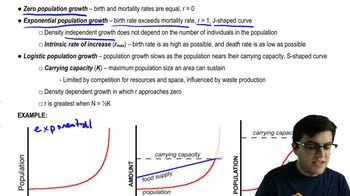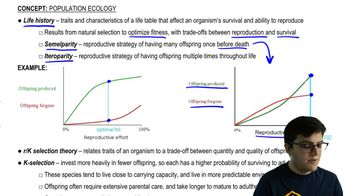Dispersion is the distribution of individuals in a population throughout an area. We're going to look at 3 types of dispersion here. The first is random. And in random dispersion, the position of one individual is independent from another in the population. Usually, this is due to random factors like wind dispersals. So if you can imagine a dandelion blowing its seeds off into the wind, you might end up with a dispersion of those seeds like you see here, totally random. Now, clumped is going to be when the organisms group together, and usually, this is due to social factors. And you can see here we have these groups of organisms clumping together in the population. The last type we're going to look at is uniform. And in uniform dispersion, the individuals are more or less evenly spaced throughout the area. It's not going to be, you know, as perfect as this image here, but they're more or less evenly spaced, and it's usually due to competition for resources. In fact, you can especially see this if the animals rather express territoriality. So they have a territory, this bounded space that they're going to defend. So if each of these organisms is defending its territory then, you know, they're going to have a distribution that spaces them out because they're going to have to, you know, make sure their territories don't overlap, for example. Now one way that population ecologists estimate population size, because as you can imagine it's impractical and kind of impossible to just go and try to count every single organism. So one of the methods they use is the mark-recapture method. And basically, what you do is you capture some organisms, and you mark them, like you can see with this snail here, and then these marked organisms will be released into the wild again. Ecologists will later capture another group from the population, and they'll look at the recaptured group for marked organisms. And usually they'll iterate this a few times, so you can see here's, like, the initial batch of organisms they catch, and here's the or I should write recapture here. Right? Because they've recaptured a few. And, you know, they'll usually iterate this a few times and then use statistical models to estimate population size. You guys don't need to worry about the math, just the general idea of capturing a group of organisms, marking them, and then capturing new groups, and seeing how many in the new group are marked. With that, let's go ahead and flip the page.
Table of contents
- 1. Introduction to Biology2h 40m
- 2. Chemistry3h 40m
- 3. Water1h 26m
- 4. Biomolecules2h 23m
- 5. Cell Components2h 26m
- 6. The Membrane2h 31m
- 7. Energy and Metabolism2h 0m
- 8. Respiration2h 40m
- 9. Photosynthesis2h 49m
- 10. Cell Signaling59m
- 11. Cell Division2h 47m
- 12. Meiosis2h 0m
- 13. Mendelian Genetics4h 44m
- Introduction to Mendel's Experiments7m
- Genotype vs. Phenotype17m
- Punnett Squares13m
- Mendel's Experiments26m
- Mendel's Laws18m
- Monohybrid Crosses19m
- Test Crosses14m
- Dihybrid Crosses20m
- Punnett Square Probability26m
- Incomplete Dominance vs. Codominance20m
- Epistasis7m
- Non-Mendelian Genetics12m
- Pedigrees6m
- Autosomal Inheritance21m
- Sex-Linked Inheritance43m
- X-Inactivation9m
- 14. DNA Synthesis2h 27m
- 15. Gene Expression3h 20m
- 16. Regulation of Expression3h 31m
- Introduction to Regulation of Gene Expression13m
- Prokaryotic Gene Regulation via Operons27m
- The Lac Operon21m
- Glucose's Impact on Lac Operon25m
- The Trp Operon20m
- Review of the Lac Operon & Trp Operon11m
- Introduction to Eukaryotic Gene Regulation9m
- Eukaryotic Chromatin Modifications16m
- Eukaryotic Transcriptional Control22m
- Eukaryotic Post-Transcriptional Regulation28m
- Eukaryotic Post-Translational Regulation13m
- 17. Viruses37m
- 18. Biotechnology2h 58m
- 19. Genomics17m
- 20. Development1h 5m
- 21. Evolution3h 1m
- 22. Evolution of Populations3h 52m
- 23. Speciation1h 37m
- 24. History of Life on Earth2h 6m
- 25. Phylogeny2h 31m
- 26. Prokaryotes4h 59m
- 27. Protists1h 12m
- 28. Plants1h 22m
- 29. Fungi36m
- 30. Overview of Animals34m
- 31. Invertebrates1h 2m
- 32. Vertebrates50m
- 33. Plant Anatomy1h 3m
- 34. Vascular Plant Transport2m
- 35. Soil37m
- 36. Plant Reproduction47m
- 37. Plant Sensation and Response1h 9m
- 38. Animal Form and Function1h 19m
- 39. Digestive System10m
- 40. Circulatory System1h 57m
- 41. Immune System1h 12m
- 42. Osmoregulation and Excretion50m
- 43. Endocrine System4m
- 44. Animal Reproduction2m
- 45. Nervous System55m
- 46. Sensory Systems46m
- 47. Muscle Systems23m
- 48. Ecology3h 11m
- Introduction to Ecology20m
- Biogeography14m
- Earth's Climate Patterns50m
- Introduction to Terrestrial Biomes10m
- Terrestrial Biomes: Near Equator13m
- Terrestrial Biomes: Temperate Regions10m
- Terrestrial Biomes: Northern Regions15m
- Introduction to Aquatic Biomes27m
- Freshwater Aquatic Biomes14m
- Marine Aquatic Biomes13m
- 49. Animal Behavior28m
- 50. Population Ecology3h 41m
- Introduction to Population Ecology28m
- Population Sampling Methods23m
- Life History12m
- Population Demography17m
- Factors Limiting Population Growth14m
- Introduction to Population Growth Models22m
- Linear Population Growth6m
- Exponential Population Growth29m
- Logistic Population Growth32m
- r/K Selection10m
- The Human Population22m
- 51. Community Ecology2h 46m
- Introduction to Community Ecology2m
- Introduction to Community Interactions9m
- Community Interactions: Competition (-/-)38m
- Community Interactions: Exploitation (+/-)23m
- Community Interactions: Mutualism (+/+) & Commensalism (+/0)9m
- Community Structure35m
- Community Dynamics26m
- Geographic Impact on Communities21m
- 52. Ecosystems2h 36m
- 53. Conservation Biology24m
50. Population Ecology
Introduction to Population Ecology
Struggling with General Biology?
Join thousands of students who trust us to help them ace their exams!Watch the first videoVideo duration:
3mPlay a video:
Related Videos
Related Practice


































































